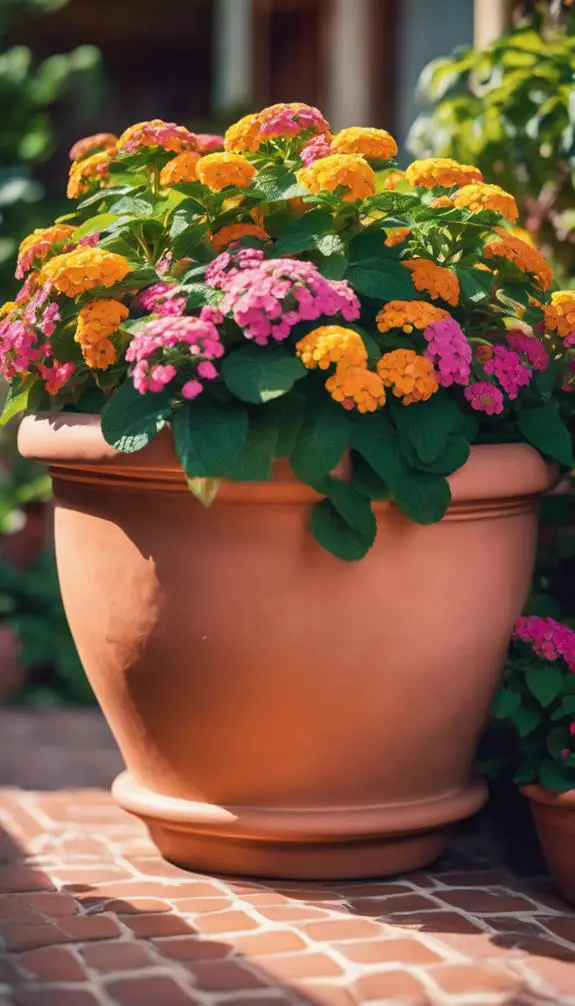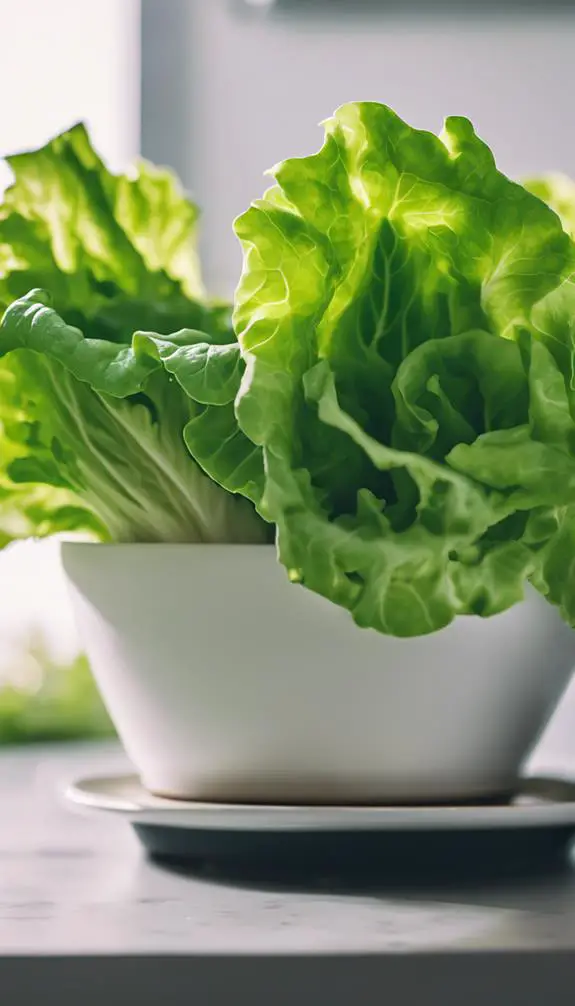When it comes to growing lettuce in raised beds, you're just a few simple steps away from enjoying a fresh, crisp harvest. You've likely already considered the benefits of raised bed gardening, but do you know the specific techniques to coax tender lettuce leaves from the soil? From selecting the right variety to mastering the art of sowing, watering, and harvesting, there are key strategies to guarantee a bountiful crop. By following these expert tips, you'll be snipping fresh lettuce leaves in no time – but first, let's start with the foundation: choosing the perfect lettuce variety for your raised bed.
Summary
- Select a lettuce variety suitable for raised beds, considering growth rate, leaf shape, and temperature tolerance.
- Prepare the soil by loosening the top 6-8 inches, adding organic matter, and mixing well to improve structure and fertility.
- Sow lettuce seeds about 1/8 inch deep and 2-4 inches apart, depending on the variety, and thin to the recommended spacing.
- Ensure consistent moisture, providing about 70-80% of the plant's composition, and use mulch to retain moisture and suppress weeds.
- Position the raised bed to receive morning sun exposure, guaranteeing at least 4-6 hours of direct sunlight for healthy growth.
Choosing the Right Lettuce Variety

When deciding to grow lettuce, selecting the right variety is crucial for a successful harvest.
You'll want to ponder factors like growth rate, leaf shape, and temperature tolerance.
Lettuce classification is based on leaf type, with four main categories: crisphead, butterhead, romaine, and loose-leaf.
Crisphead varieties, like 'Iceberg', have dense, compact heads, while butterhead types, like 'Boston', have loose, tender leaves.
Romaine varieties, such as 'Rouge d'Hiver', have upright, crisp leaves.
Loose-leaf varieties, like 'Red Leaf', have delicate, flavorful leaves.
Lettuce breeding has led to a wide range of varieties, each with unique characteristics.
Preparing the Raised Bed Soil
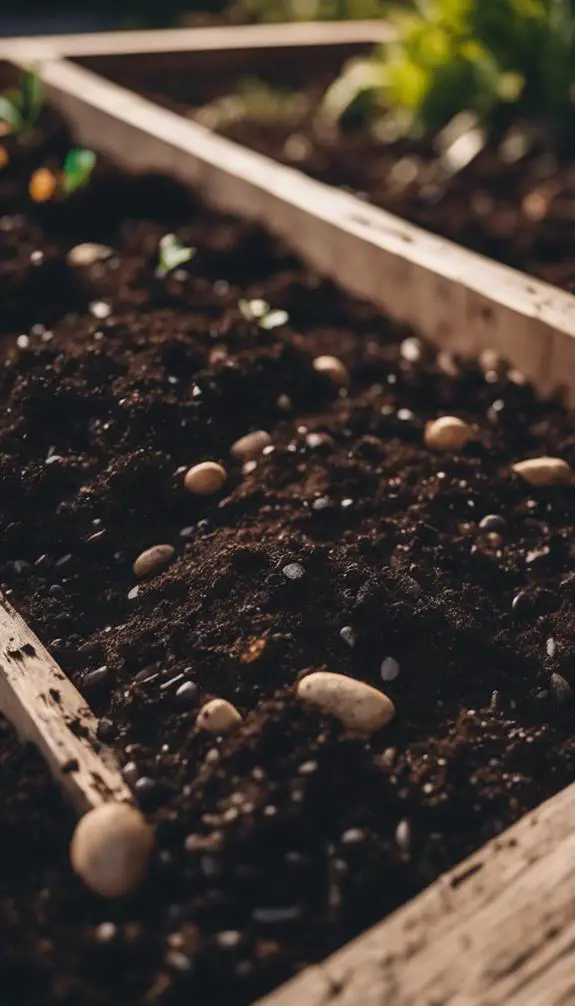
With your lettuce variety selected, the time has come to prepare the soil in your raised bed.
Before sowing, verify your soil is well-draining and aerated. Soil aeration is vital as it promotes healthy root growth and prevents waterlogging.
Use a garden fork to gently loosen the top 6-8 inches of soil, taking care not to compact it. Soil compaction can hinder root development, so it's imperative to avoid stepping on the bed or using heavy gardening tools.
Add a 2-inch layer of organic matter like compost or well-rotted manure to improve soil structure and fertility. Mix it well into the existing soil, and your raised bed will be ready for lettuce cultivation.
Sowing Lettuce Seeds Correctly

Sowing lettuce seeds correctly is crucial for ideal germination and growth.
You'll want to sow seeds about 1/8 inch deep and 2-4 inches apart in your raised bed.
For loose-leaf lettuce, you can broadcast seeds and thin to 4-6 inches apart as they grow.
For romaine or buttercrunch lettuce, sow seeds in rows, with seeds spaced about 4-6 inches apart.
Make sure the soil is moist but not waterlogged, as this can hinder lettuce germination.
Cover the seeds with a thin layer of soil, and gently firm the soil with your hands or a gentle tamping tool.
This will guarantee good contact between the seeds and soil, promoting healthy growth.
Watering and Mulching Techniques

About 70 to 80 percent of lettuce's composition is water, making consistent moisture crucial for its growth.
You'll want to guarantee your raised bed receives a steady supply of water, especially during hot or dry spells. Consider implementing drip irrigation, which delivers water directly to the roots, reducing evaporation and runoff. For peak results, you should water your lettuce plants when the top 2-3 inches of soil feel dry to the touch.
To retain moisture and suppress weeds, apply a layer of organic mulch, such as straw or grass clippings, around your plants.
Soil blankets, made from natural materials like jute or coconut coir, can also be used to insulate the soil and reduce moisture loss. By adopting these watering and mulching techniques, you'll create an ideal environment for your lettuce to thrive.
Providing Optimal Sunlight Conditions

When growing lettuce, you'll want to provide ideal sunlight conditions to promote healthy growth.
To do this, position your lettuce bed to receive morning sun exposure, as this gentle light stimulates leaf growth without causing scorching.
Morning Sun Exposure
Your lettuce plants crave morning sun exposure, which is essential for their healthy development.
This exposure triggers a process called photomorphogenesis, where plants respond to light by regulating their growth and development.
To provide peak morning sun exposure, guarantee your raised bed receives direct sunlight for at least 4-6 sunlight hours.
An early start is pivotal, as morning sun helps regulate the plant's circadian rhythm.
By getting an early start, you'll promote healthy growth, increase yields, and reduce the risk of disease.
Position your raised bed to receive morning sun, and watch your lettuce plants thrive.
South-Facing Bed Orientation
To maximize morning sun exposure, position your raised bed in a south-facing orientation, which allows it to capture the sun's rays at their strongest and most direct.
This bed positioning guarantees your lettuce receives the perfect amount of sunlight, especially during winter when the sun is lower in the sky.
A south-facing orientation also promotes air circulation, reducing the risk of fungal diseases that thrive in humid environments.
By aligning your raised bed with the sun's path, you'll create a microclimate that fosters healthy growth and development.
This precise positioning will give your lettuce the best chance to thrive, even in the cooler winter months when sunlight is scarce.
Shaded Afternoon Protection
While morning sun is essential for lettuce growth, intense afternoon sun can be detrimental, causing scorching and bolting.
To prevent this, you'll want to provide shaded afternoon protection. One effective solution is to install a shade cloth over your raised bed.
This will filter out intense sunlight, reducing heat stress on your lettuce plants. For even more precise control, consider using an afternoon filter, which can be adjusted to allow ideal sunlight levels.
Maintaining Soil Temperature
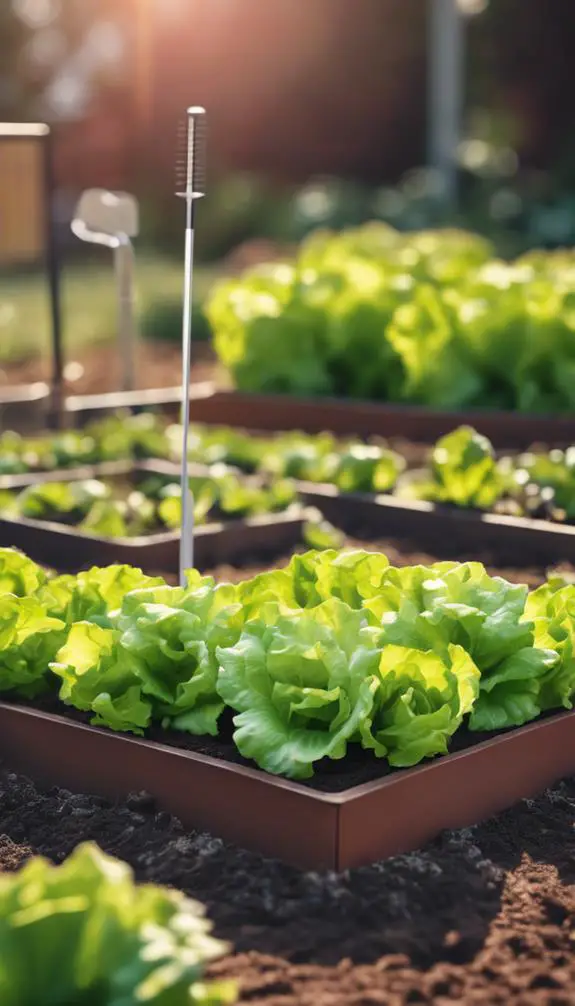
Three to five days after sowing, the soil temperature begins to play a vital role in lettuce germination and growth.
You'll want to monitor soil temperature closely, as it can fluctuate markedly between daytime and nighttime. Invest in a soil thermometer to track temperature changes and guarantee prime conditions for your lettuce.
Ideally, the soil temperature should range from 60°F to 70°F (15°C to 21°C) for peak germination. Temperature fluctuations can slow down or even halt germination, so it's essential to maintain a consistent temperature.
Fertilizing for Healthy Growth

One crucial aspect of growing healthy lettuce is providing it with the necessary nutrients, which is where fertilization comes in.
You'll want to guarantee your lettuce receives a balanced diet of nitrogen, phosphorus, and potassium (NPK) to promote peak growth. For lettuce nutrition, a fertilizer with a ratio of 5-5-5 NPK is ideal.
Additionally, consider the soil pH, as lettuce prefers a slightly acidic to neutral soil pH between 6.0 and 7.0.
You can use a fertilizer specifically formulated for vegetables or a balanced, water-soluble fertilizer. Apply the fertilizer according to the manufacturer's instructions, usually once a week, to provide your lettuce with the necessary nutrients for healthy growth.
Controlling Weeds and Pests

Among the most significant challenges you'll face when growing lettuce is dealing with weeds and pests that can quickly overrun your crop and undermine its health.
To combat this, you'll need to implement effective weed control measures. One approach is to lay down weed barriers, which prevent weeds from germinating and competing with your lettuce for water and nutrients.
Another strategy is to apply mulch layers, which can suppress weed growth and retain moisture in the soil. Additionally, you can use physical barriers, such as fine-mesh screens, to keep pests like slugs and snails at bay.
Pruning for Continuous Harvest

You'll want to harvest your leafy greens when they're young and tender, as this encourages the plant to produce more leaves.
To do this, simply trim off the largest leaves at the base of the plant, leaving the smaller ones intact.
Harvesting Leafy Greens
With your lettuce plants now mature, it's time to reap the rewards of your labor by harvesting the leafy greens.
You've worked hard to create the perfect conditions for your lettuce to thrive, and now it's time to enjoy the fresh greens.
To harvest, simply snip off the largest leaves at the base of the plant, leaving about an inch of stem intact.
This will encourage the plant to continue producing new growth.
Aim to harvest your leafy delights in the morning, when the leaves are at their crispest.
Use scissors or pinch off individual leaves to avoid damaging the plant.
You'll be enjoying a continuous supply of fresh, crisp lettuce in no time!
Trimming for Regrowth
Now that you've started harvesting your lettuce, it's time to focus on pruning your plants for continuous growth.
To promote healthy regrowth, trim your lettuce plants to about 1-2 inches from the soil surface. This encourages the plant to focus energy on producing new leaves rather than seed production.
For ideal lettuce density, prune your plants on a regular cutting schedule, about every 7-10 days. This will stimulate the plant to produce new growth, ensuring a continuous harvest.
Dealing With Common Lettuce Pests
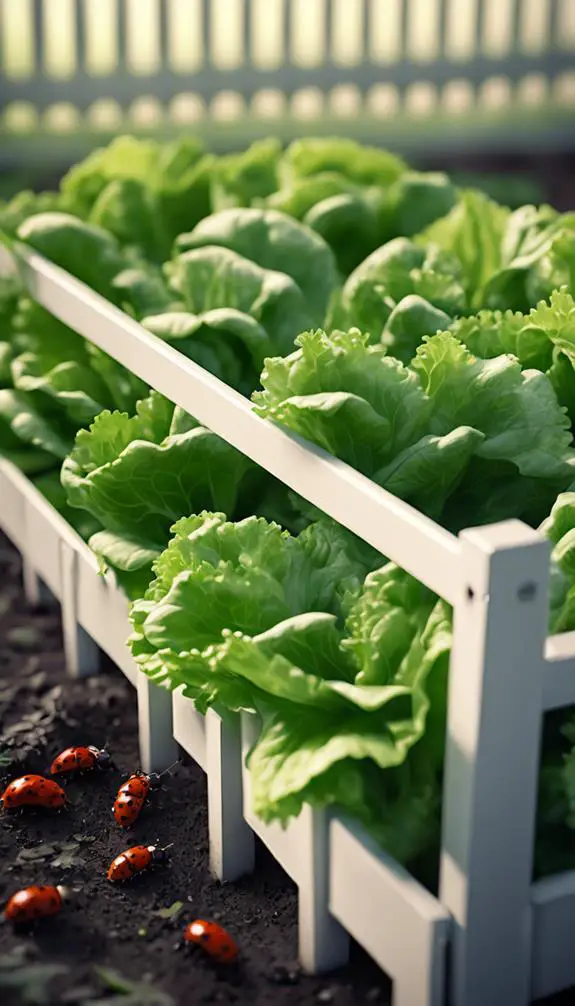
Slugs and snails can wreck havoc on your lettuce crop, leaving behind a trail of ragged holes and slimy trails in their wake.
These pests are most active at night, so taking proactive precautions is vital. You can use copper tape or crushed eggshells around the raised bed to deter them.
For more severe infestations, consider using organic baits like iron phosphate or beer traps.
Aphid infestations are another common issue, spreading diseases and weakening your lettuce plants.
Inspect your plants regularly, and use neem oil or insecticidal soap to control aphid populations.
Keep your raised bed clean, removing any debris or weeds that may attract pests.
Harvesting Lettuce at the Right Time
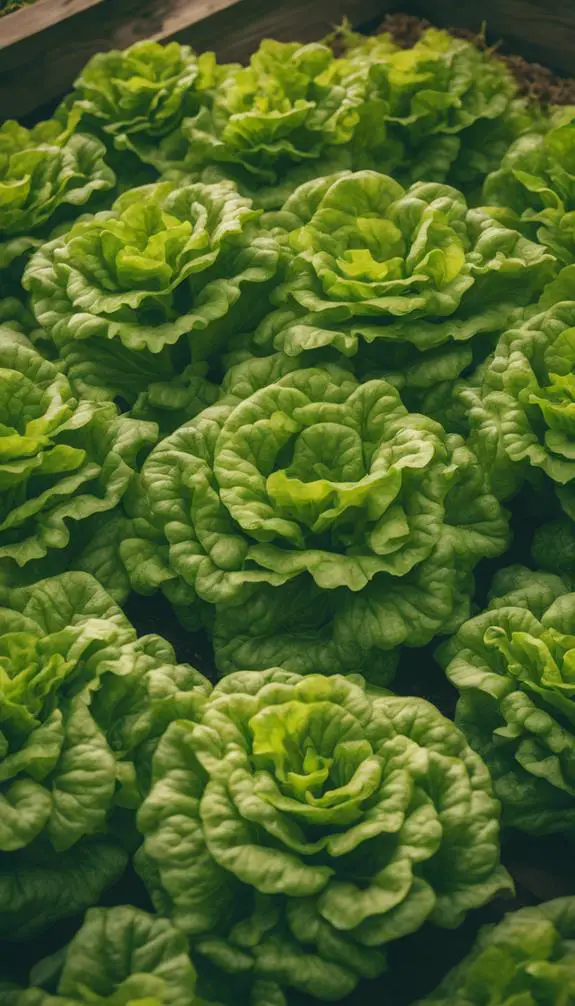
You've invested time and effort into nurturing your lettuce crop, and the moment of truth has finally arrived: it's time to harvest.
Timing is vital to guarantee you get the best flavor and texture. Check your lettuce daily, as it can go from perfect to over-mature in just a few days.
For loose-leaf varieties, harvest individual leaves when they reach 4-6 inches tall. For head-forming types, wait until the heads are firm and compact.
Aim to harvest in the morning, when leaves are at their crispest. Consider the harvest cycle when planning your next crop, as lettuce can be grown in as little as 20-30 days.
Storing Freshly Harvested Lettuce
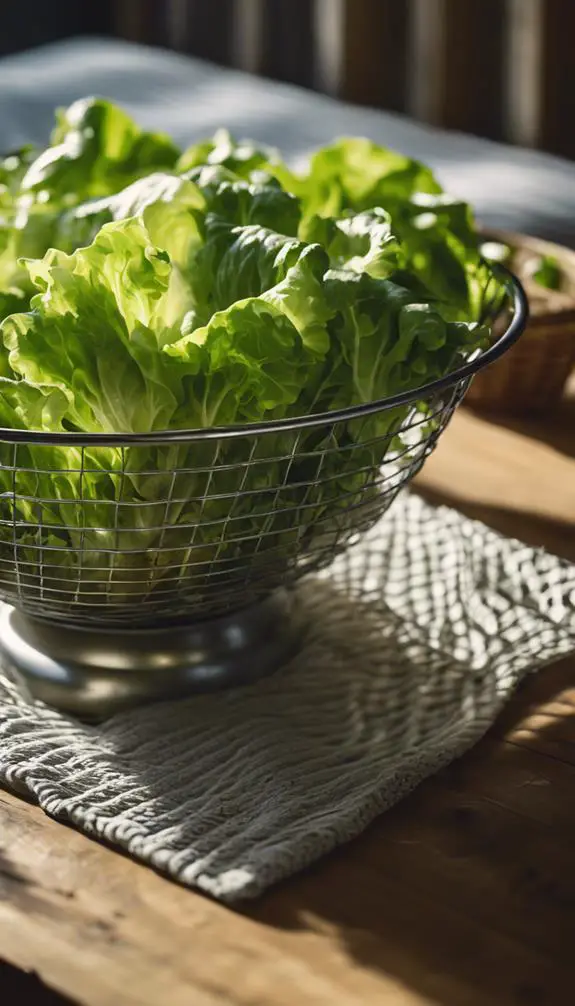
Harvesting lettuce at the right time is only half the battle; proper storage is equally important to maintain its freshness and quality.
You'll want to store your freshly harvested lettuce in a way that preserves its crispness and flavor. Consider using lettuce crispers, which are specifically designed to keep lettuce fresh by maintaining high humidity and preventing moisture loss.
When refrigerating your lettuce, use refrigeration methods that keep the temperature between 32°F and 40°F (0°C and 4°C). Make sure to store the lettuce in a breathable container or bag to prevent moisture buildup.
Troubleshooting Common Issues
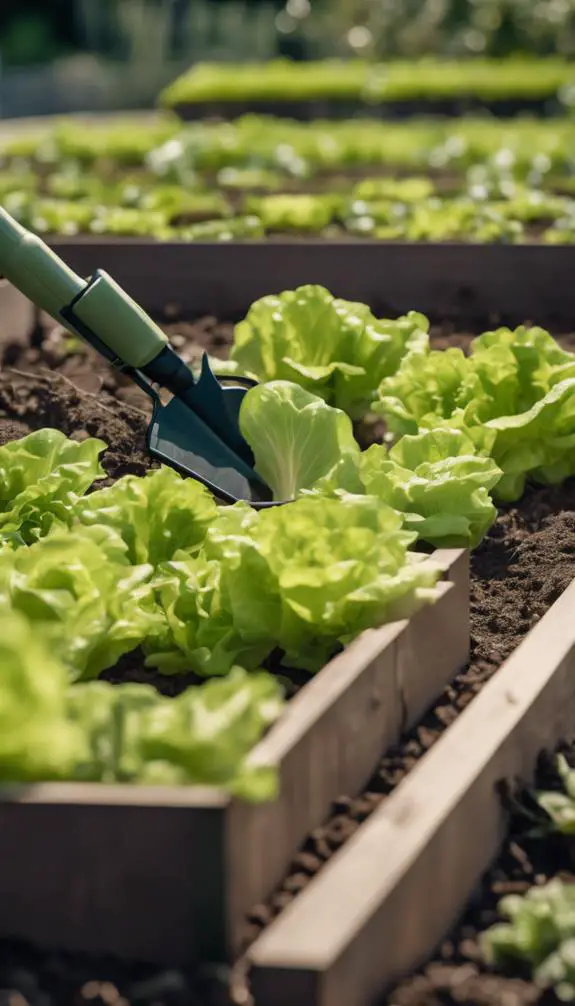
As you grow lettuce, you'll likely encounter pests and predators that can hinder your crop's growth.
You may also notice your lettuce wilting away, which can be a frustrating and puzzling problem.
Identifying and addressing these common issues quickly is vital to saving your crop and ensuring a healthy harvest.
Pests and Predators
Check your lettuce crop regularly for signs of pests and predators, which can quickly devastate your yield if left unchecked.
Slugs, in particular, can be a major problem, as they'll chew through leaves and stems, leaving behind telltale holes and slime trails. For effective slugs control, try placing copper tape around the raised bed or using crushed eggshells to deter them.
Cabbage moths are another common issue, laying eggs that hatch into caterpillars that'll eat through your lettuce. To prevent this, use fine-mesh row covers or introduce natural predators like ladybugs and lacewings into your garden.
Regular monitoring and prompt action will help you stay ahead of these pests and predators, ensuring a healthy and thriving lettuce crop.
Lettuce Wilting Away
While you're keeping those pests and predators at bay, you may still face another common issue: lettuce wilting away.
Lettuce droop can be a frustrating sight, especially when you've invested time and effort into nurturing your crop.
One major culprit behind lettuce wilting is leaf stress, which occurs when the plant is unable to absorb sufficient water.
This can be due to inadequate soil moisture, high temperatures, or poor drainage.
To address this, guarantee your raised bed has good drainage and maintain consistent soil moisture levels.
You can also provide shade for your lettuce during the hottest part of the day to reduce leaf stress.
FAQs
Can I Grow Lettuce in Partial Shade or Indoor Conditions?
You can grow lettuce in partial shade, as it's relatively shade-tolerant, but guarantee it receives at least 4 hours of direct light exposure daily; indoor conditions with 12-14 hours of indirect light also work, but may lead to slower growth.
How Often Should I Rotate My Lettuce Crop in the Raised Bed?
When you're growing lettuce, you'll want to rotate your crop every 2-3 weeks to avoid soil fatigue, which can lead to reduced yields and increased disease susceptibility, ensuring a healthy and thriving crop rotation.
Can I Use a Trellis to Support Tall Lettuce Varieties?
You can utilize a trellis to support tall lettuce varieties, opting for sturdy obelisk or fan-shaped trellis types that provide leafy frameworks for ideal growth, while ensuring air circulation and sunlight penetration for a healthy harvest.
Will Lettuce Regrow if I Cut It Too Close to the Soil?
When you cut lettuce too close to the soil, you risk reducing its regrowth rate. To avoid this cutting error, leave about an inch of stem intact, as this will promote healthy regrowth and allow the lettuce to recover quickly.
Can I Grow Lettuce in the Same Bed as Other Vegetables?
You can optimize vegetable harmony through companion planting, pairing lettuce with compatible veggies like carrots, radishes, or beans, but avoid planting with members of the Brassica family, like broccoli or cauliflower, which may compete for resources.
Conclusion
You've successfully grown lettuce in your raised bed by following the steps outlined above. Remember to monitor your crop's progress, adjusting your techniques as needed. Keep the soil consistently moist, and maintain a weed-free environment. With proper care, you'll enjoy a continuous harvest of fresh, crisp lettuce. Store your harvest properly to preserve its quality, and be prepared to troubleshoot any issues that may arise.


